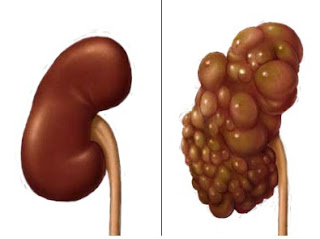Polycystic kidney disease (PKD) is an inherited disorder in which clusters of cysts develop primarily within your kidneys. Cysts are noncancerous round sacs containing water-like fluid. The cysts vary in size and, as they accumulate more fluid, they can grow very large.
Usually the most severely affected organs are kidneys, but polycystic kidney disease can cause cysts to develop in your liver and elsewhere in your body. The disease causes a variety of serious complications. High blood pressure and Kidney failure are common problems for people with polycystic kidney disease. Polycystic kidney disease varies greatly in its severity.
Causes
Abnormal genes cause polycystic kidney disease, and the genetic defects mean the disease runs in families. Rarely, a genetic mutation can be the cause of polycystic kidney disease.
Types of PKD
PKD can be divided into two types:autosomal dominant polycystic kidney disease (ADPKD) and the less common autosomal recessive polycystic kidney disease( ARPKD).
- Autosomal dominant polycystic kidney disease (ADPKD). Signs and symptoms of ADPKD often develop between the ages of 30 and 40. In the past, this type was called adult polycystic kidney disease, but children can develop the disorder.
Only one parent needs to have the disease in order for it to pass along to the children. If one parent has ADPKD, each child has a 50 percent chance of getting the disease. This form accounts for about 90 percent of cases of polycystic kidney disease. - Autosomal recessive polycystic kidney disease (ARPKD). This type is far less common than is ADPKD. The signs and symptoms often appear shortly after birth. Sometimes, symptoms don't appear until later in childhood or during adolescence.
Both parents must have abnormal genes to pass on this form of the disease. If both parents carry a gene for this disorder, each child has a 25 percent chance of getting the disease.
Polycystic kidney disease symptoms may include:
- High blood pressure
- Back or side pain
- Headache
- Increase in the size of your abdomen
- Blood in your urine
- Frequent urination
- Kidney stones
- Kidney failure
- Urinary tract or kidney infections
Tests and diagnosis
Tests for detecting the size and number of kidney cysts you have are:- Ultrasound exam. During an ultrasound, a wand-like device called a transducer is placed on your body. It emits inaudible sound waves that are reflected back to the transducer — like sonar. A computer translates the reflected sound waves into images of your kidneys.
- Computerized tomography (CT) scan. As you lie on a movable table, you're guided into a big doughnut-shaped device that projects very thin X-ray beams through your body. Your doctor is able to see cross-sectional images of your kidneys.
- Magnetic resonance imaging (MRI) scan. As you lie inside a large cylinder, magnetic fields and radio waves generate cross-sectional views of your kidneys.
TreatmentsSuperfine Chinese Medicine Osmotherapy
Superfine Chinese Medicine Osmotherapy is an external therapy based on traditional Chinese herbal medicine. First our specialists select the effective Chinese herb formulas after they thoroughly investigate your case, Second, the Chinese herbs in the formulas are made superfine powders, Third, the powders are activated by heat or superconducting, Finally, by osmosis devices, the activated superfine medicines will be applied to the acupoints of Kidney and other organs. The effective ingredients penetrate the skin and permeate into kidney lesions directly.
The ingredients of scientifically composed Chinese medicine herbs can dredge blood vessels, accelerate blood circulation on cysts wall as well as drive the absorption of cystic fluid into blood vessels and then get discharged out of the body through urine. The size of cysts will become smaller. In addition, the microcirculation in kidneys is improved, more oxygen and nutrients will reach to kidneys. The active ingredients also stimulate the self-renewal of impaired kidney tissues and improve renal functions.
Symptomatic treatment
As the most common treatments , treating polycystic kidney disease involves dealing with the symptoms and complications in their early stages: In case of high bllod pressure, controlling it may delay the progression of the disease and slow further kidney damage. Combining a low-sodium, low-fat diet that's moderate in protein and calorie content with not smoking, increasing exercise and reducing stress may help control high blood pressure. Chronic pain, usually located in your back or your side, is a common symptom of polycystic kidney disease. Often, the pain is mild and you can control it with over-the-counter medications containing acetaminophen. While symptomatic treatment can release some discomfort or slow the disease progression, it can not halt its progression.
Surgery
The enlarged cysts will cause extreme pain. In these cases, surgery may be needed to remove the cysts. Although surgery can relieve the pain, the small cysts will become large soon after the enlarged ones are removed, and the pain may come again. Also as an invasive medical procedure, most patients are reluntant to take it unless they have noother choices. Talk with our experts for Traditional Chinese Medicine options in your special case.
Dialysis and kidney transplant
The size and number of the cysts may increase with time as patients get over 60. More enlarged cysts will further damage kidney tissues and result in progressive renal function deterioration, eventually, lead to Kidney Failure. Dialysis and kidney transplant are necessary. For patiens of Polycystic kidney disease, our suggestions are: well observing the advances of the condition and treating it early. Talk with our Chinese Medicine Specialists for suitable treatments in our hospital.

没有评论:
发表评论